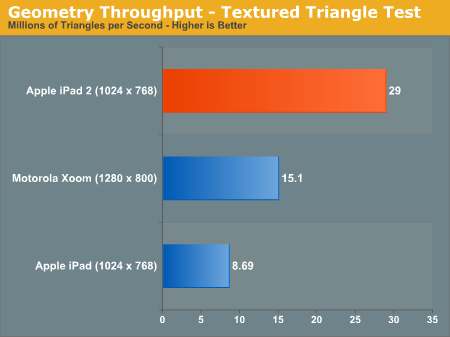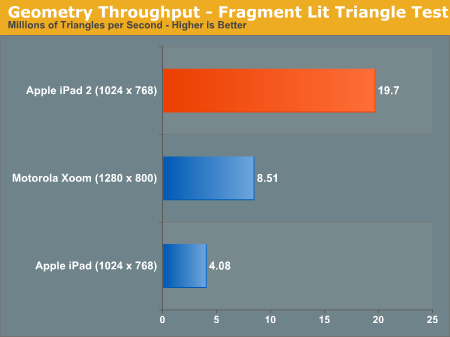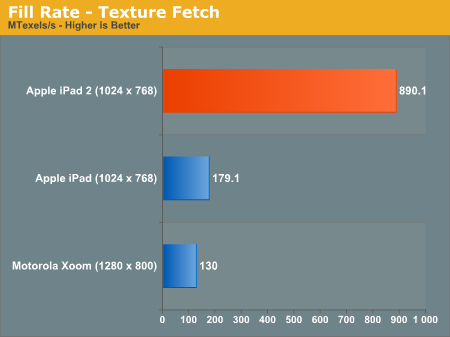Apple iPad 2 GPU Performance Explored: PowerVR SGX543MP2 Benchmarked
by Anand Lal Shimpi on March 12, 2011 3:04 PM EST- Posted in
- Smartphones
- Apple
- iPad
- GLBenchmark
- iPad 2
- Mobile
- Tablets
Earlier this morning we published our first impressions on Apple's iPad 2, including analysis on camera quality and a dive into the architecture behind Apple's A5 SoC. Our SoC investigation mostly focused on CPU performance, which we found to be a healthy 50% faster than the A4 in the original iPad - at least in web browsing. We were able to exceed Apple's claim of up to 2x performance increase in some synthetic tests, but even a 50% increase in javascript and web page loading performance isn't anything to be upset about. We briefly touched on the GPU: Imagination Technologies' PowerVR SGX 543MP2. Here Apple is promising up to a 9x increase in performance, but it's something we wanted to investigate.
Architecturally the 543MP2 has more than twice the compute horsepower of the SGX 535 used in Apple's A4. Each shader pipeline can execute twice the number of instructions per clock as the SGX 535, and then there are four times as many pipes in an SGX 543MP2 as there are in a 535. There are also efficiency improvements as well. Hidden surface removal works at twice the rate in the 543MP2 as it did in the 535. There's also a big boost in texture filtering performance as you'll see below.
As always we turn to GLBenchmark 2.0, a benchmark crafted by a bunch of developers who either have or had experience doing development work for some of the big dev houses in the industry. We'll start with some of the synthetics.
Over the course of PC gaming evolution we noticed a significant increase in geometry complexity. We'll likely see a similar evolution with games in the ultra mobile space, and as a result this next round of ultra mobile GPUs will seriously ramp up geometry performance.
Here we look at two different geometry tests amounting to the (almost) best and worst case triangle throughput measured by GLBenchmark 2.0. First we have the best case scenario - a textured triangle:

The original iPad could manage 8.7 million triangles per second in this test. The iPad 2? 29 million. An increase of over 3x. Developers with existing titles on the iPad could conceivably triple geometry complexity with no impact on performance on the iPad 2.
Now for the more complex case - a fragment lit triangle test:

The performance gap widens. While the PowerVR SGX 535 in the A4 could barely break 4 million triangles per second in this test, the PowerVR SGX 543MP2 in the A5 manages just under 20 million. There's just no competition here.
I mentioned an improvement in texturing performance earlier. The GLBenchmark texture fetch test puts numbers to that statement:

We're talking about nearly a 5x increase in texture fetch performance. This has to be due to more than an increase in the amount of texturing hardware. An improvement in throughput? Increase in memory bandwidth? It's tough to say without knowing more at this point.
| Apple iPad vs. iPad 2 | ||||
| Apple iPad (PowerVR SGX 535) | Apple iPad 2 (PowerVR SGX 543MP2) | |||
| Array test - uniform array access |
3412.4 kVertex/s
|
3864.0 kVertex/s
|
||
| Branching test - balanced |
2002.2 kShaders/s
|
11412.4 kShaders/s
|
||
| Branching test - fragment weighted |
5784.3 kFragments/s
|
22402.6kFragments/s
|
||
| Branching test - vertex weighted |
3905.9 kVertex/s
|
3870.6 kVertex/s
|
||
| Common test - balanced |
1025.3 kShaders/s
|
4092.5 kShaders/s
|
||
| Common test - fragment weighted |
1603.7 kFragments/s
|
3708.2 kFragments/s
|
||
| Common test - vertex weighted |
1516.6 kVertex/s
|
3714.0 kVertex/s
|
||
| Geometric test - balanced |
1276.2 kShaders/s
|
6238.4 kShaders/s
|
||
| Geometric test - fragment weighted |
2000.6 kFragments/s
|
6382.0 kFragments/s
|
||
| Geometric test - vertex weighted |
1921.5 kVertex/s
|
3780.9 kVertex/s
|
||
| Exponential test - balanced |
2013.2 kShaders/s
|
11758.0 kShaders/s
|
||
| Exponential test - fragment weighted |
3632.3 kFragments/s
|
11151.8 kFragments/s
|
||
| Exponential test - vertex weighted |
3118.1 kVertex/s
|
3634.1 kVertex/s
|
||
| Fill test - texture fetch |
179116.2 kTexels/s
|
890077.6 kTexels/s
|
||
| For loop test - balanced |
1295.1 kShaders/s
|
3719.1 kShaders/s
|
||
| For loop test - fragment weighted |
1777.3 kFragments/s
|
6182.8 kFragments/s
|
||
| For loop test - vertex weighted |
1418.3 kVertex/s
|
3813.5 kVertex/s
|
||
| Triangle test - textured |
8691.5 kTriangles/s
|
29019.9 kTriangles/s
|
||
| Triangle test - textured, fragment lit |
4084.9 kTriangles/s
|
19695.8 kTriangles/s
|
||
| Triangle test - textured, vertex lit |
6912.4 kTriangles/s
|
20907.1 kTriangles/s
|
||
| Triangle test - white |
9621.7 kTriangles/s
|
29771.1 kTriangles/s
|
||
| Trigonometric test - balanced |
1292.6 kShaders/s
|
3249.9 kShaders/s
|
||
| Trigonometric test - fragment weighted |
1103.9 kFragments/s
|
3502.5 kFragments/s
|
||
| Trigonometric test - vertex weighted |
1018.8 kVertex/s
|
3091.7 kVertex/s
|
||
| Swapbuffer Speed |
600
|
599
|
||
Enough with the synthetics - how much of an improvement does all of this yield in the actual GLBenchmark 2.0 game tests? Oh it's big.











219 Comments
View All Comments
tipoo - Saturday, March 12, 2011 - link
Way more powerful than the PSP, and eons ahead of the DS. The PSP2/NGP will use the quad core version of this same GPU though.TEAMSWITCHER - Saturday, March 12, 2011 - link
The Android fan-boys have spent a good deal of smack-talk on the Tegra-2 processor. I assumed they knew what they were talking about, and the iPad 2 would be a bit anemic in the graphics department. This is a huge revelation - I hope more mainstream web sites pick up on this story.bplewis24 - Saturday, March 12, 2011 - link
If you didn't see this coming you probably don't have the best grasp of the subject matter. It has been very clear for a while that the PowerVR SGX543 would be better than the GeForce ULV GPU in Tegra2.The CPUs are fairly close in performance, with Tegra 2 generally maintaining an edge in the synthetic benchmarks so far. Go read other reviews (including on this site) for that info, but the GPU performance of the A5 SoC is superior.
The "smack talk" was not wrong, your interpretation of it was. And until we get the full iPad2 review from Anandtech, it still remains to be seen which overall hardware/software package is better. Remember, the Xoom has Android 3.0 while iOS 4.3 is still pretty much inferior from a tablet perspective.
Brandon
TEAMSWITCHER - Saturday, March 12, 2011 - link
Sorry, I didn't fully understand the subtleties of low-voltage GPU specifications. I was under the impression that the Xoom and other Android tablets would have more competitive silicon - maybe the others will.solipsism - Sunday, March 13, 2011 - link
"Remember, the Xoom has Android 3.0 while iOS 4.3 is still pretty much inferior from a tablet perspective.”Remember, that’s a load of crap. Apple designed iOS for iPad long before Honeycomb was even on Google’s radar. The fact is that iOS for iPad is much better designed for the tablet than any other mobile OS on the market. Android 3.0 as some nice features but it’s still playing performance catch up to an iPad OS that was demoed over a year ago.
UltimateTruth - Monday, March 14, 2011 - link
"Honeycomb" was in development for tablets for several years. Long before the iPad. Having some tweaks,the iOS is really no different on the iPad than it is on the iPhone. It's the SAME OS!solipsism - Monday, March 14, 2011 - link
Same OS as on Macs? Sure, they all use Darwin.Same CocoaTouch development platform for the main I/O? Sure, they are both iOS?
Same OS that can be moved from device to the other with only a few tweaks as you suggest? Not even close. We’re talking an entirely new UI to accommodate the aspect ratio, size and pixel density differences.
bplewis24 - Tuesday, March 15, 2011 - link
So, Anand's Xoom/Honeycomb review is a "load of crap" huh? Maybe you should check it out:"Simply put: the Xoom puts the iPad to shame. Particularly over WiFi the web browsing experience is just awesome. It’s like using a netbook, which in this case isn’t meant as a knock but rather a compliment.
It’s not all about performance though, functionally the Honeycomb Browser is a huge improvement over anything else out there: it supports tabbed browsing. I can’t stress how much better this makes browsing on a tablet. "
"Honeycomb feels a lot like Google’s take on iOS without sacrificing any of what makes Android unique. It’s a healthy combination of the appliance-like iOS without giving up any of the user facing customization & flexibility that Android users love."
"I’m impressed with what Google has done with the UI. It’s a definite modernization of what Android is all about. There are elements of the Android UI we’re used to within Honeycomb but they aren’t all that prevalent at the surface. This looks and feels like a brand new OS for Google."
"Am I more likely to use the Xoom than the iPad? Yes. The hardware is faster but more importantly, the software is better suited for multitasking. I’m a bigger fan of Honeycomb’s multitasking UI & notification system compared to the double-tap-home and passive notifications you get with the iPad and iOS. I can be more productive with the Xoom than I can be with the iPad as a result. I don’t believe Honeycomb’s UI is perfect by any means, it’s just more multitasking oriented than iOS is at this point."
Nice try, though.
rquick - Sunday, March 13, 2011 - link
"Remember, the Xoom has Android 3.0 while iOS 4.3 is still pretty much inferior from a tablet perspective." That was a joke, right? Pretty funny.metafor - Monday, March 14, 2011 - link
Actually, as an iOS user who played with Honeycomb for the first time a week back, I have to say, iOS is showing its age. It was a great interface for its time but many advances (better notifications, widgets, stacks, homescreens, fast multitasking, consolidation of different social networking feeds, etc..) in other OS's UI's like WebOS, WP7 and now Android have pretty much surpassed it.Time will tell if iOS will change to catch up to these features. Folders are godawful and awkward; that and program switching seem "tacked on" rather than an intuitive part of the OS. Then there's the lack of consolidated hubs, which makes checking facebook, then email, then thumblr kinda cumbersome.